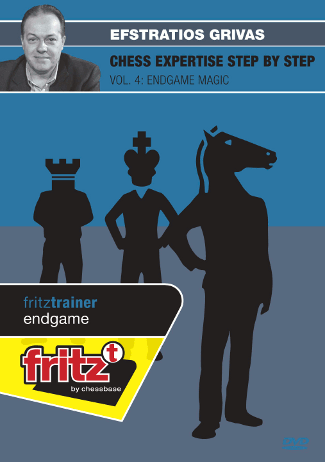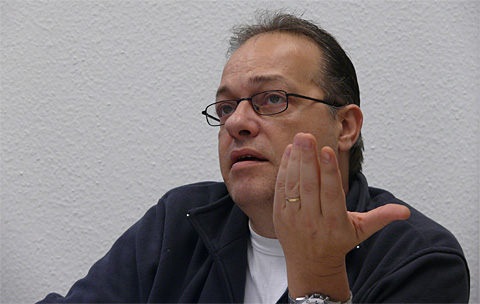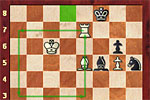 Walking
the Path
Walking
the Path
By Michael McGuerty
Chess Expertise Step by Step: Vol. 4, Endgame Magic (DVD), by Efstratios
Grivas, ChessBase, Video running time: 4 hours, $33.95 (ChessCafe Price: $27.95)
My review of
the companion volume, Chess Expertise Step by Step: Vol. 3, Rook Handling,
made its way into the August 2012 "ChessBase Cafe" column here at
ChessCafe.com. I mentioned there that GM Grivas is not the
most animated presenter and that he speaks somewhat quickly with a heavy accent
in a deep, gravelly voice, but the viewer soon becomes acclimated to his style
of delivery and enunciation and inflections.
The contents of this DVD are divided as follows:
- About the author
- Introduction
- The Isolani in the Endgame (five segments)
- Rook & RP vs Bishop & RP (fourteen segments)
- The Square (four segments)
- Queen vs Rook (eight segments)
- Shattered Pawns (four segments)
- Pawn Endings (five segments)
- Rook vs Bishop-pair (seven segments)
In the "About the author" segment, Grivas lists his extensive accomplishments
as a chess trainer and author. He is a FIDE Senior Trainer (Secretary of the
FIDE Trainers' Commission), an International FIDE Chess Arbiter, and an International
FIDE Chess Organizer. He has won several medals at various Olympiads and, in
2010, he was awarded the FIDE TRG Boleslavsky Medal for best author of 2009.
It is a bit unnecessary to include this as a video clip; a paragraph of text
in the index window would have sufficed.

In the introduction, Grivas explains the concept of this DVD:
"Many people think that the qualities of the grandmaster, compared to
an ordinary player, mostly consists of superior opening preparation, greater
calculating abilities, and deeper understanding of typical middelgame positions.
If you, however, take a closer look at games, say, from a strong Open tournament,
you will notice several cases where the grandmaster outplays a weaker player
or even a fellow grandmaster in the endgame from more or less equal positions.
You are often left wondering, how on earth could someone lose such a simple
position with so few pieces on the board.
"And yet, in my personal experience, the last part of the game is where
a well-educated player can set the opponent the most problems. The weight
of each moves increases; each mistake can prove very costly; and great accuracy
is required. In our times, with the abolition of adjournments and the increasingly
faster time-controls endgame knowledge has acquired greater significance than
ever before. This DVD, called "Endgame Magic," tries to cover important
parts in this field and help to assimilate knowledge, and understand in depth,
the proper handling of the endgame in certain cases.
"We will examine how to benefit from the isolani in the endgame; how
to try to win or defend when a rook and rook-pawn vs a bishop and rook-pawn
(on the same side) endgame arises; the technique of the 'square' when the
advantage of the exchange-up seems to be difficult to capitalize; how to win
or defend with a plain queen vs a plain rook; how to benefit from our opponent's
shattered pawns; how to play some specific pawn endings; and, finally, what
are the problems of the exchange-up when facing the bishop-pair. As Laurence
Fishburne has mentioned in Matrix, 'There is a difference between knowing
the path and walking the path.'"
It may seem surprising that the section with the most segments is "Rook
& RP vs Bishop & RP," but time-wise many of these have the shortest
duration; the longest clip here is just shy of seven minutes, while the majority
are three to five minutes in length. The longest clip overall can be found in
the "Pawn Endings" section, clocking in at slightly more than sixteen
minutes.
Since the concept of "The Square" may be the least self-explanatory
of the contents, let's have a look at it. Grivas admits that the title of this
segment may be misleading because it is a survey of the ending rook and bishop
and pawn versus bishop and knight and pawn, when there are no passed pawns and
the bishops are of opposite colors. "But as the usual winning maneuver
is the 'rook-square' move it is useful to call it 'The Square.'"
The first example is from Kasparov-Karpov, FIDE-Wch Lyon (16), 01.12.1990.

[Event "World Championship 35th-KK5"] [Site "Lyon/New York"] [Date "1990.12.01"]
[Round "16"] [White "Kasparov, Garry"] [Black "Karpov, Anatoly"] [Result "1-0"]
[ECO "C45"] [WhiteElo "2800"] [BlackElo "2730"] [SetUp "1"] [FEN "5k2/4R3/2K3p1/4BbPn/8/8/8/8
w - - 0 89"] [PlyCount "27"] [EventDate "1990.10.??"] [EventType "match"] [EventRounds
"24"] [EventCountry "USA"] [Source "ChessBase"] [SourceDate "1991.04.01"] {Here
the game was adjourned for the second time. Judging from all the features the
position is a winning one for White, and in end the logic of chess triumphed.
To win the game, Kasparov has to walk his king to the square d8. He can only
do it by having his rook moving around a magical square, which is described
by a7-, a3-, e3- and e7-squares.} 89. Ra7 $1 {Drawing one side of the square.}
(89. Bh2 Kxe7) 89... Bg4 90. Kd6 Bh3 ({The alternative is} 90... Bf5 91. Ra3
{[Grivas skips through these lines at a fast pace, just taking a "quick look."]}
Kf7 (91... Ke8 92. Re3 Kf7 93. Kc7 Be6 (93... Ke6 94. Bh2+ Kd5 95. Re7 Bc2 96.
Kd8 Ba4 97. Re5+ Kd4 98. Re6 Bc2 99. Ke7 $18) 94. Kd8 Bd5 95. Bb2 Nf4 96. Re7+
Kg8 (96... Kf8 97. Ba3 Kg8 98. Re8+ Kg7 99. Ke7 $18) 97. Ra7 Nd3 98. Bd4 Kf8
99. Rd7 Bc4 100. Rd6 $18) 92. Re3 Be6 (92... Bg4 93. Kc7 Ke6 94. Bh2+ Kf7 (94...
Kd5 95. Re7 Bf5 96. Kd8 Bc2 97. Ke8 $18) 95. Kd8 Be6 (95... Ng7 96. Re7+ Kf8
97. Bd6 Kg8 98. Be5 Ne6+ 99. Ke8 Bf5 100. Rb7 $18) 96. Ra3 Ng7 97. Ra7+ Kg8
98. Ke7 $18) (92... Bc2 93. Kd7 Ba4+ 94. Kd8 Ke6 95. Bh2+ Kd5 ( 95... Kf5 96.
Re5+ Kg4 97. Re4+ $18) 96. Ke7 Kd4 97. Ra3 $18) 93. Kc7 Ke7 94. Bb2 Nf4 95.
Ba3+ Kf7 96. Rf3 $18) 91. Ra3 $1 {The second side of the square is born. But
why has the rook land on the square a3? It prevents the black knight from jumping
to the square g3.} Bg4 92. Re3 Bf5 93. Kc7 Kf7 94. Kd8 {The king's journey is
over and White pushes the black king from the f-file.} Bg4 95. Bb2 $1 {Kasparov
makes an important bishop move precisely in a moment when the black knight can't
move. It opens the road for the rook to come back to the square e7.} Be6 ({After}
95... Nf4 96. Re7+ Kf8 97. Ba3 Kg8 98. Re4 Ne6+ 99. Ke7 {Black loses one of
his pieces or the two pieces for his rook.}) 96. Bc3 $1 {An accurate waiting
move which puts Black in a zugzwang position.} Bf5 (96... Nf4 $2 97. Rf3 $18)
97. Re7+ {Returning where it all began, the rook finishes the square journey.}
Kf8 98. Be5 {The domination is complete: the knight at the edge has no moves.
White can easily force the black king to the corner.} Bd3 99. Ra7 Be4 100. Rc7
{Kasparov is looking for a free square on the eighth rank for his rook.} ({It
was possible to play directly} 100. Bd6+ Kg8 101. Ke7 Ng7 102. Be5 $18) 100...
Bb1 101. Bd6+ Kg8 102. Ke7 ({And Black resigned, as after} 102. Ke7 Ng7 103.
Rc8+ Kh7 104. Be5 Nf5+ 105. Kf8 {he has no defense against 106.Rc7+.}) 1-0
Grivas concludes that this endgame is "easy" in that "White
has a very concrete plan" and "difficult" because White "has
to be accurate at certain moments." For sure, this section is somewhat
esoteric for the average player. The segments on the isolani, pawn endings,
queen vs rook, and shattered pawns will all have more practical significance.
Whereas Grivas used many of his own games as models on the previous DVD in
this series, none here are from his own practice. It is Gelfand and Kasparov
who appear the most times at three games each, and Svidler and Topalov at two
games. The famous game Salwe-Rubinstein makes an appearance, as do game examples
from Kramnik, Ivanchuk, Spassky, Smyslov, Fischer, Müller, and others.
In each case, the examples are well-chosen for the topic being presented. It
is also useful that Grivas includes the majority of his "script" in
the game annotations; thus, you do not have to replay the video segment to review
his spoken commentary.
Chess Expertise Step by Step: Vol. 4, Endgame Magic covers many important
topics that are necessary to know in order to become a more accomplished player.
Perhaps by the time the viewer has worked through the first three volumes they
will be ready to absorb the contents of this one. Chess Expertise Step by
Step: Vol. 3, Rook Handling was recommended to players of all levels; for
Chess Expertise Step by Step: Vol. 4, Endgame Magic, it is probably
of benefit to be a stronger player at the outset.
My assessment of this product: Good (four out of six stars)
An apology
At the time of publication of this review it had escaped our attention
– as it had the attention of the original reviewer at Chess Cafe
– that the analysis provided by GM Grivas was in fact taken, often
verbatim, from a
Huffington Post article published by GM Lubomir Kavalek two years
ago. The oversight is especially embarrassing since the original Huffington
article had appeared on
our newspage as well. The matter has been minutely documented in
a subsequent article by Kavalek's entitled "Heavy
Lifting".
|
Chess Training in Hamburg by Efstratios Griva
 |
Efstratios Grivas: Endgame Magic
30.01.2012 – The Greek grandmaster is a highly
experienced chess trainer and chess author. He has participated in the
ChessBase sponsored program of training sessions for talented young players.
In addition he has recorded a number of training DVDs, the latest of which
deals with the endgame. In addition to a description of this product we
bring you a
valuable lesson in an important ending.
|
 |
Grivas: Chess Expertise Step by Step
05.11.2011 – Greek grandmaster Efstratios Grivas
is a highly experienced chess trainer and chess author. He has participated
in the ChessBase sponsored program of training sessions for talented young
players. In addition he has recorded a number of training DVDs, the latest
of which deals with rook handling in the endgame, with four hours of personal
video instructions. Do
not miss this one. |
 |
Grivas Training: Building a Repertoire
18.04.2011 – "In contrast to the middlegame
and the endgame, where theory is objective and accepted by everyone, in
the opening each chess player makes his choices in accordance with his
emotions and his personal experience. No opening
loses, no opening wins."
World renown chess trainer GM Efstratios Grivas explains how you should
build your repertoire in Part
3 of his lecture series. |
 |
Grivas Training: Getting to Know Ourselves
13.02.2011 – Young chess players need to be
able to identify the assets and weaknesses of their chess personalities.
Many trainers and trainees have wondered how this can be done properly.
The basic resource are one's recent games, which are used to produce an
"X-ray image" of one's chess-self. GM Efstratios Grivas, a world-class
trainer, tells us how to go about it, in Part
2 of his lecture series. |
 |
ChessBase Training with GM Efstratios Grivas (Part 1)
28.01.2011 – How do you help talented young
chess players to realize their potential? Working with a world-class trainer
is a good way to start. ChessBase has started a program to sponsor a series
of training sessions, which started, logically, in our offices in Hamburg.
Five young talents got a full-day session with an internationally known
chess coach, who has graciously placed his entire lecture at
our disposal.
|


















 Walking
the Path
Walking
the Path










